Gettingthere (talk | contribs) |
Gettingthere (talk | contribs) |
||
| Line 41: | Line 41: | ||
==Add an end-node on cul-de-sac's== | ==Add an end-node on cul-de-sac's== | ||
(this section needs work) | (this section needs work and photos) | ||
In order for the Waze Application to route properly from a location on a cul-de-sac, an end-node or dead-end-node needs to be added at the end of each cul-de-sac road. Without this end-node Waze will give the instruction 'Proceed to Hilighted Route'. Basically an end-node is a junction at the end of the cul-de-sac. | In order for the Waze Application to route properly from a location on a cul-de-sac, an end-node or dead-end-node needs to be added at the end of each cul-de-sac road. Without this end-node Waze will give the instruction 'Proceed to Hilighted Route'. Basically an end-node is a junction at the end of the cul-de-sac. | ||
Revision as of 21:33, 10 January 2012
Creating a new road
You have a location where there should be a road where there isn't one in Waze, such as a recent suburban development. The following series of screenshots and instructions walk you through the process of adding a road to Waze from scratch. The screenshots are from an area of Little Rock, Arkansas, US and we are working on adding the roads missing in the highlighted area shown here:
Set up the map display such that you can see a good portion of the area you need to add the road to, setting the zoom level appropriately such that you will be able to follow the curves in the road as you draw it.
There are four steps essential to add roads to the Waze map:
- Draw the road, including junctions to existing segments
- Confirm the road properties
- Set allowed turns
- Save the changes
Drawing the road
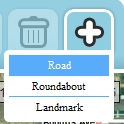
Hover the cursor over the large + icon at the right side of the toolbar and click Road. You can also use the keyboard shortcut which is the letter i, for Insert. Move the cursor to the location you want to start drawing the road. This can be an empty location, or can on an existing segment where the intersection with this new road will be. The cursor has a small blue circle to indicate it is in drawing mode.
When you hover over an existing segment, it will highlight showing that if you click right there, a junction will be automatically added for you where you start drawing.
Move your mouse along the path of the road, and as you follow along the aerial or GPS points for the new road, every time you click, a geometry node is added, keeping your new road aligned with your cursor movement. When you reach the end location for the new road, double-click the mouse. You will exit drawing mode, and the new road will display in orange to signify that it is unsaved.
In the situation being describe here, there is another road in this same view which is missing. We can add another road to the map without having saved the first one, which is a great timesaver. The next screenshot shows the second road already added and auto-junctioned to the first segment we added.
At this point, you can save the newly added roads if you wish. However, the process of properly adding the roads is not complete. These roads are currently still set as 1-way, with no associated city and no street name. Adding those details to the road is required before they will show up in the client, and is discussed below in the Updating details to confirm roads section below.
Add an end-node on cul-de-sac's
(this section needs work and photos)
In order for the Waze Application to route properly from a location on a cul-de-sac, an end-node or dead-end-node needs to be added at the end of each cul-de-sac road. Without this end-node Waze will give the instruction 'Proceed to Hilighted Route'. Basically an end-node is a junction at the end of the cul-de-sac.
Too add a end-node, draw a temporary street and junction this temporary street at the end of the cul-de-sac. After the end-node is created, you can then delete the temporary road.
The result is an end-node which appears in the map editor as a blue, square dot.
Confirm the road by updating details
New roads will not be displayed on the Waze app until they are confirmed, meaning an editor confirms the correct city and street name at a minimum. In the map editor, unconfirmed roads are displayed in Red. Unconfirmed roads can both be roads drawn in the editor as well as roads recorded or paved from the app. To confirm a road, you verify and set the road type, directionality and level.
First, select the segment(s) you need to confirm. Notice in the case below, we can see these are two 1-way segments. Once selected, if the properties drawer has not slid out to the left, click the tab to open it. Notice below that for the one road, there are now two segments. That is because the second road we added has split the original road into two segments. This is normal and expected. You can choose to confirm the first road before added the second road if you wish.
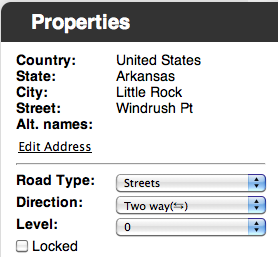
To edit the address details, click the Edit Address link. This will enable editing of fields above it. When multiple segments are selected, you need to select Country (and State for locations which support it) as well as entering in city and street name information. If this is a location outside a city, use the "No Name" check box. Same for the street name. If this is a private drive or a parking lot road or other road which doesn't have a name, use the "No Name" check box.
When complete, click the Apply button, then set the correct Road Type, Direction and Level. For neighborhood streets in these examples, Street is appropriate, they are 2-way streets and they have no roads above or below them, so Level 0 is correct.
Again, you can choose to save now, but there is one last step which needs to be completed before we can call this process complete: setting the allowed turns
Set allowed turns (connections)
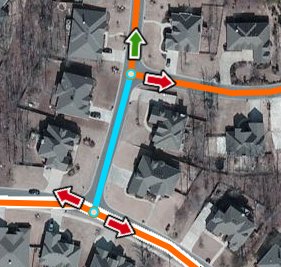
We've added our roads and confirmed them, but we haven't set which roads can be legally driven from and to. In the real world, sometimes two 2-way segments are connected, but direction of travel is restricted in a certain way, due to such things as a median barrier being across the road. However, in our suburban neighborhood example, these streets can all be driven to and from, but our screenshot to the left shows red arrows, meaning that Waze won't navigate that direction from the selected segment.
In situations where not all turns are allowed, you would click on each arrow to allow that turn, or travel direction. But if all turns are allowed, then the faster way is to enable all turns at the junction.

Select the junction and it will turn from an orange to red with a white border.
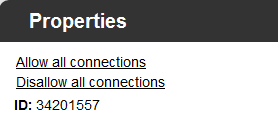
Look to the Properties drawer and you will see action links for this junction. Depending on the current state of the junction, both or either Allow all connections or Disallow all connections links will appear. (If all connections are currently allowed, then that link will not appear.)
To enable all turns at our intersections, click the Allow all connections link for both of the junctions created.
Save
Up to this point, you may have saved your progress or not. If not, click the Save button now (or use the Ctrl+s keyboard shortcut) and all of your updates will be sent to the Waze servers for processing. After the save is complete, and if there are no errors, you will be presented with the final product of this process:
Editing existing roads
Editing an existing road or segment is not very different than creating a new road. Once a road is drawn from scratch, before it is saved, all of the editing functions described here work just the same.
Adjusting geometry
Adjusting geometry is changing the shape or the way a road segment looks. You need to do this for roads after they are realigned in real life, or perhaps a whole area is in the wrong place because the basemap import has the roads in the wrong place.
The instructions here, while written initially for editing an existing road segment, also apply to a new road segment you just created but have not yet saved. The editor treats them the same.
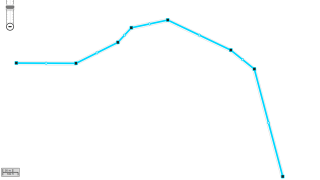
To start adjusting the geometry of a segment, click on it. As it is highlighted, when you hover over the segment, geometry nodes and internodes will display on the segment. Both of these are draggable so that you can reposition them wherever you need. When you drag an internode from its default position 1/2 was between two nodes, it will turn into a node.
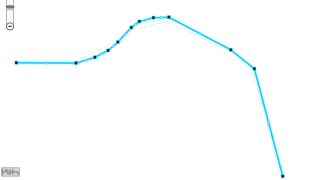
To delete a node, which you would want to do to straighten out a section of the segment, hover the cursor over a node and hit the d key on the keyboard. This only works with nodes, not internodes. When you have a long straight stretch of road, and you see there are nodes located along it, it makes sense to delete these as it makes the road segment more simple and easier to display on the Waze client app.
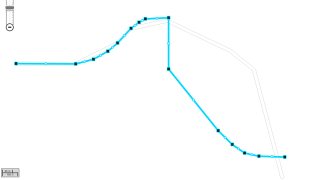
When complete, the segment is now a different geometry than it was to start with.
Don't forget to save!
To see these operations more easily, you can watch a video of adjusting segment geometry.
Junctions
Moving junctions
Allow/Disallow connections
(Re)Moving a road from a junction
Updating details
Setting allowed turns (connections)
Roundabouts
See Creating and Editing a roundabout for guidance on roundabouts or traffic circles.





